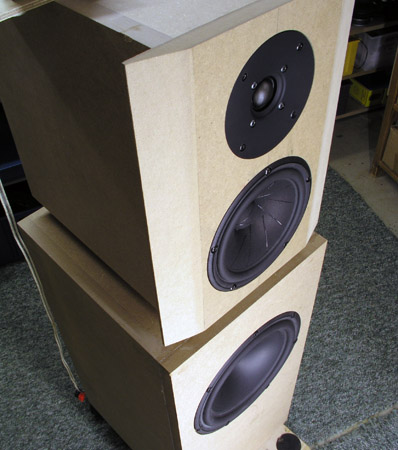I've had these drivers for over a year sitting in my closet. I've been hoping to put something together but I guess after taking a year to finish the NatalieP, I kind of got sick of speaker projects (took me so long because of the cabinet work, wanted to go gloss black but never could get the surface perfect. Bondo was a mess and corners weren't perfectly sharp on the top and bottom edges. Never was able to figure out a way to fix them either. I pretty much lost interest. Anyway I digress... back to topic). So with this much money invested in drivers, it'd be a shame not to do anything with them. Then again, I still have to invest in a mic and a sound card. (cheap and effective solutions/recommendations are welcome  )
)
So first, what do you think of this combination of drivers; the bottom end / midbass region is what I'm worried about the most? In the case of the NatP I think they sound a bit thin (probably due my shallow / heavy stuffed cabinet, with top firing port) in that regard and matting them to a big old servo Velodyne 15" has proven to be difficult. Will the single RSS315 per side give a full and nicely integrated/transitioning midbass and low end?
Should I just go the simple cabinet route and build a rectangle? A part of me wants something that looks exotic, like Usher's Be-20 but I think my enthusiasm would drop to zero after realizing how much work it would be. I thought about the prefabbed stuff from Madisound, but I already invested in the table saw, clamps, etc; plus they are expensive and shipping would probably be a deal breaker. I then thought about a dipole but I have limited space so acoustically that might not be a good idea.
Yeah I'm full of words and ideas in this post, hopefully you guys can help steer this project in the right direction. I certainly will need advice/help when measuring and designing the crossover.
 )
)So first, what do you think of this combination of drivers; the bottom end / midbass region is what I'm worried about the most? In the case of the NatP I think they sound a bit thin (probably due my shallow / heavy stuffed cabinet, with top firing port) in that regard and matting them to a big old servo Velodyne 15" has proven to be difficult. Will the single RSS315 per side give a full and nicely integrated/transitioning midbass and low end?
Should I just go the simple cabinet route and build a rectangle? A part of me wants something that looks exotic, like Usher's Be-20 but I think my enthusiasm would drop to zero after realizing how much work it would be. I thought about the prefabbed stuff from Madisound, but I already invested in the table saw, clamps, etc; plus they are expensive and shipping would probably be a deal breaker. I then thought about a dipole but I have limited space so acoustically that might not be a good idea.
Yeah I'm full of words and ideas in this post, hopefully you guys can help steer this project in the right direction. I certainly will need advice/help when measuring and designing the crossover.







Comment